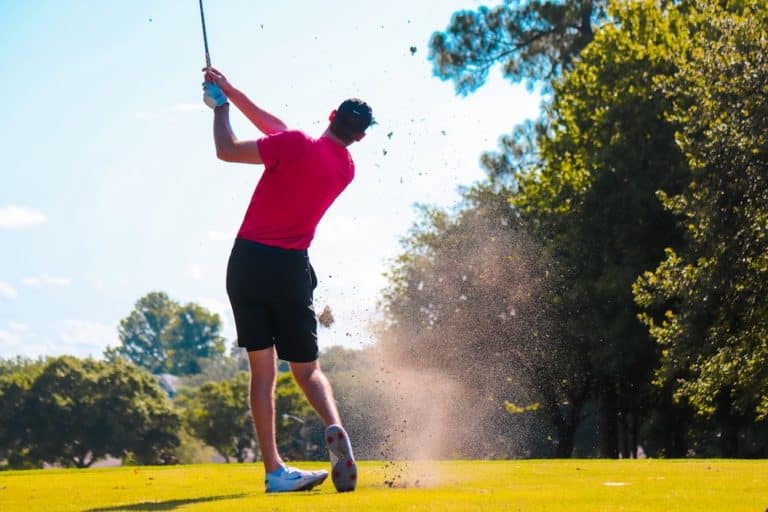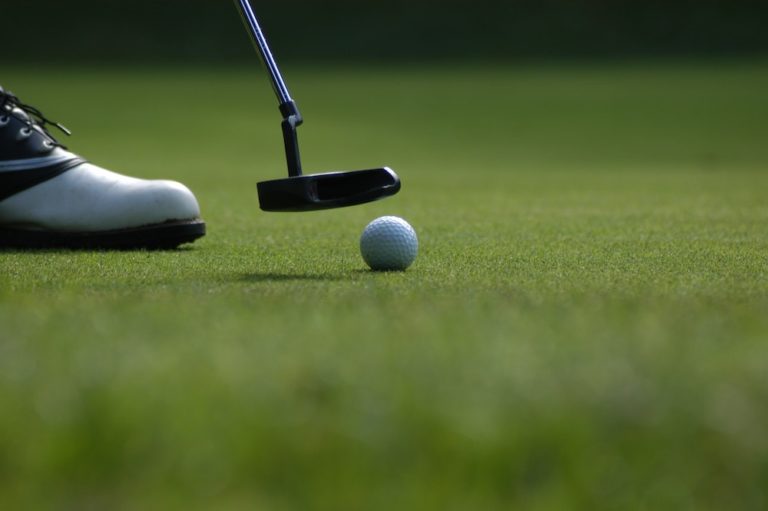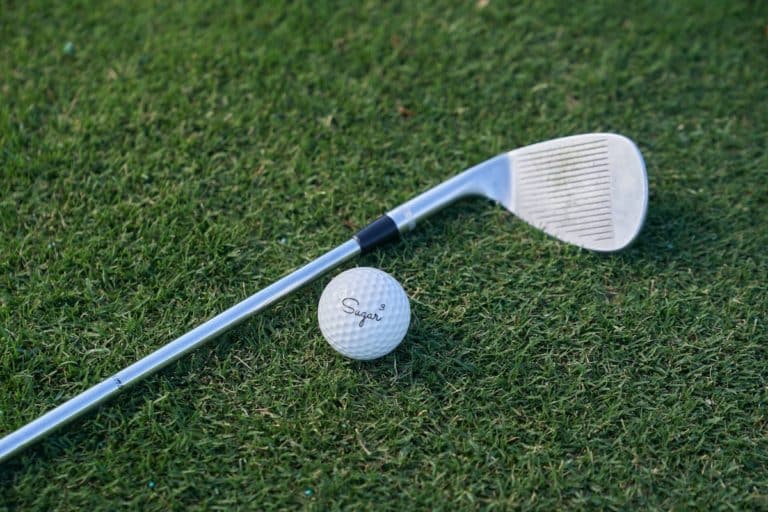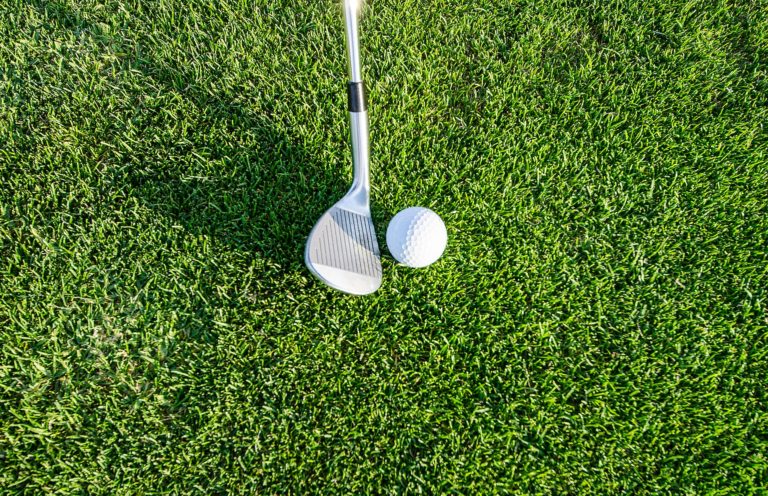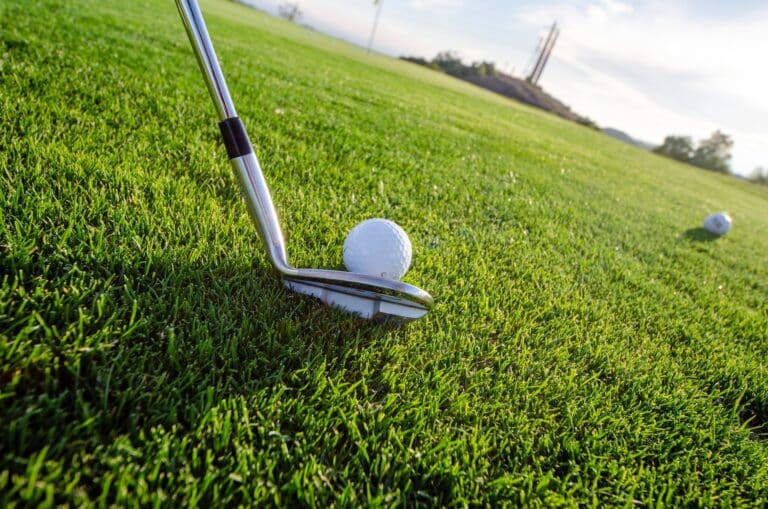Whether you’re new to the game of golf or have been playing your entire life, understanding the lingo is important. I put together this guide of the most popular golf terms so the next time you’re playing with your friends, you’ll know what they’re talking about.
Comprehensive List of Golfing Terms
A
Ace: Commonly referred to as a ‘hole-in-one,’ an ace occurs when a golfer strikes the ball into the hole with just one stroke on a par-three hole.
Address: Before taking a swing, a golfer must adopt their stance and properly position themselves in front of the ball. This is known as ‘addressing’ the ball.
Approach Shot: This is a golfer’s second shot (or third on par-five holes) that is aimed to land on the green. Precision and distance control are crucial here to set up a simpler putt.
Air Mail: A term used when a player hits the ball over the green, making it essentially ‘fly’ over the entire putting surface and into the rough beyond.
Albatross: A rare feat in golf, an albatross is achieved when a golfer scores three strokes under par on a single hole. It’s also known as a ‘double eagle’ and is considered to be one of the most challenging shots in golf.
Alignment: The act of positioning the body and club in a straight line, aiming towards the target. Proper alignment is essential for accuracy and consistency in golf shots.
Amateur: A player who does not play golf for monetary gain or profit. Amateurs can compete in tournaments but are not allowed to accept cash prizes.
Attend The Flag: The act of holding or removing the flagstick from the cup for another player while they putt.
B
Back Nine: The second half of an 18-hole golf course.
Backspin: A type of spin that causes the ball to roll backward after it lands on the green. This is typically achieved by hitting the ball with a lofted clubface and is used to control the speed and direction of the ball.
Bag Drop: An area designated for players to drop off their golf bags before parking or heading to the first tee.
Ball Marker: A small, flat object used to mark the position of a player’s ball on the green while they attend to other tasks, such as removing debris or repairing ball marks.
Bunker: Also known as sand traps, bunkers are depressions on the golf course filled with sand and designed to pose a challenge to the golfer. They require a different technique to escape, often with a high, soft shot.
Birdie: A score of one stroke under par on any individual hole. It’s a definite goal for golfers and a key milestone in lowering your handicap.
Break: The bending of the ball’s flight from the intended target, usually influenced by the contours of the green. Understanding the break is vital for making successful putts.
Buzzard: A slang term for a score of two strokes over par on an individual hole. If par is 4, then a buzzard would be shooting 6.
C
Cabbage: A slang term for the deep rough, often referring to the difficulty of getting out of it.
Caddie: An individual hired by a golfer to carry their bag and provide assistance with course strategies and club selection.
Chunk: To hit the ground before making contact with the ball, resulting in a poor shot. Also known as a ‘fat’ or ‘heavy’ shot.
Closeout: The final hole of a golf course or tournament.
Condor: The rarest score in golf, a condor is achieved when a golfer scores four strokes under par on a single hole.
Course Rating: A numerical representation of the difficulty of a golf course for an average scratch golfer. It is used to calculate handicaps.
Cup: Also known as the hole, this is the final destination for a golf ball on each green. Its diameter is 4.25 inches and its depth must be at least 4 inches.
Cut Shot: A right-handed golfer’s shot that curves gently from left-to-right.
Chip Shot: A short shot played from just off the green, designed to get the ball close to the hole. It requires a low-trajectory, controlled swing and is often played with a less-lofted club.
Closest to the Pin: Usually associated with par-three holes, it’s a friendly competition (whether formally or among playing partners) to see who can hit their ball closest to the hole from the tee box.
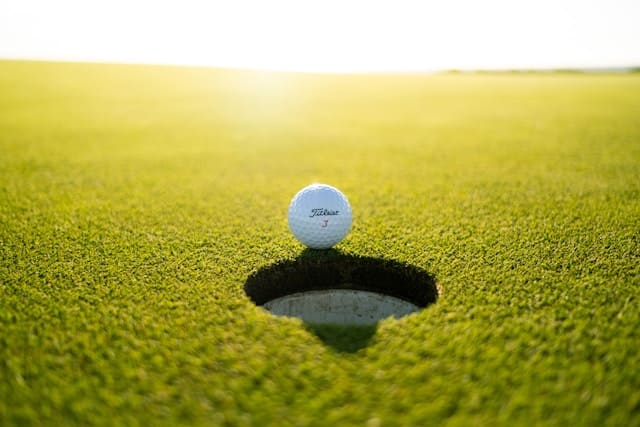
D
Divot: The clump of grass and soil displaced when a golfer takes a shot. Golf etiquette usually dictates that the divot be replaced and any damage is repaired.
Dogleg: A hole that bends, often sharply, to the left or right. This feature calls for strategic placement off the tee and can add complexity to the hole.
Double-bogey: A score that is two strokes over par on a particular hole, often seen as a setback in the golfer’s scorecard.
Double Eagle: See ‘Albatross’.
Downswing: The movement of the club towards the ball in the final stage of a golf swing. This part requires precision, timing, and power to make solid contact with the ball.
Draw: Moving the ball from right to left for a right-handed golfer.
Driver: The longest club in a golfer’s bag, typically used off the tee for maximum distance.
Duff: A slang term for a poor shot, often used interchangeably with ‘chunk’ or ‘fat.’
E
Eagle: A score that is two strokes under par on any individual hole.
Elevated Green: A green that is situated higher than the surrounding fairway, often requiring a high approach shot to reach it.
Etiquette: The customary rules and courtesy observed by golfers on the course. It encompasses behaviors such as maintaining a swift pace of play, raking bunkers, and repairing ball marks.
Executive Course: A shorter version of a golf course, usually consisting of only par-three and par-four holes. It is designed to be completed in less time than a full 18-hole course.
Expert Tee: The furthest tee box from the hole on each hole, also known as the ‘tips.’ It is reserved for skilled players who can hit long drives with consistency.
Extra Holes: When a match or round of golf is tied after 18 holes, extra holes are played to determine the winner.
F
Fairway: The closely mown area between the tee and the putting green, where golfers aim to land their shots off the tee to set up their next shot.
Fade: Similar to a ‘cut shot’, a fade sees the ball’s flight path gently moving from left to right (for right-handed golfers) without a significant curve or spin.
Fat: See ‘Chunk’.
Fore: A warning shouted by golfers to alert others that their ball may be heading in their direction, potentially causing injury.
Fringe: The closely-mown area surrounding the green, often characterized by longer grass than the putting surface itself.
Flagstick: The tall, thin pole with a flag on top marks the hole’s location and helps players see where to aim their shots. It is also referred to as the ‘pin.’
Flier: A shot unexpectedly hit farther than intended.
Foursomes: A group of four people that play a round of golf together.
Fourball: A format of golf where two teams of two golfers compete, each playing their own ball. The player with the fewest strokes on a hole wins the hole for their team.
Free Drop: A situation where a golfer can drop their ball without penalty from an unplayable lie or an abnormal course condition, such as a cart path or temporary water hazard. Rules may vary depending on the specific situation and course rules.
Front Nine: The first nine holes of an 18-hole round, starting from hole one and ending at hole 9. Also known as the ‘out’ nine.
G
Gimme: A courtesy extended among golfers where a short putt is conceded without being played. This practice allows the group to move along faster and is typically reserved for shorter putts.
Grain: The direction in which the blades of grass on a green or fairway are growing. This can affect the roll and pace of a putt.
Grand Slam: The achievement of winning all four major golf tournaments in the same calendar year.
Greens: The final destination on all golf holes, the putting green is where the flagstick and cup are located. They have a specially maintained surface designed to facilitate the putting game.
Green Fee: The price paid by each player to play a round of golf on a specific course. This fee goes towards maintaining the course and facilities.
Green in Regulation: A term used to describe when a player reaches the green in the expected number of strokes for that hole. For example, reaching a par-four green in two strokes is considered hitting the ‘green in regulation’ or ‘GIR.’
Greenskeeper: The person responsible for maintaining and grooming the golf course, including mowing grass, repairing damage, and setting up tee markers and flags. They play a crucial role in ensuring the course is playable and enjoyable for all players.
Grip: How a golfer holds the club. It is a fundamental component of the golf swing, and different grip types can affect the outcome of a shot.
Grounding: Placing the clubhead on the ground before a swing, often used to ensure that the ball is properly aligned with the intended target. Grounding the club in certain situations can result in penalty strokes.
Ground Under Repair: Areas on the course deemed temporarily unplayable or in need of maintenance. Golfers are usually allowed to take relief from these areas without penalty.
Grouping: A term used to describe the way in which golfers divide into pairs or foursomes, especially before teeing off in a competition or round.

H
Hacker: A term used to describe a golfer who is inexperienced or plays at a low skill level. It can also refer to someone who consistently hits wayward or unorthodox shots.
Half Shot: A shot played with less than full power or swing, often used on approach shots to control distance and direction.
Handicap: A system used to level the playing field in golf matches by allowing players of differing abilities to compete equally, adjusting their scores relative to par.
Hazards: A general term for any feature on a golf course that can negatively impact a golfer’s play, including water, bunkers, and out-of-bounds areas.
Heel: The part of the clubhead closest to the hosel or the connection point between shaft and clubhead. This area is often used as a reference point for golfers when aligning their shots.
Hole-in-One: A rare feat in which a golfer hits the ball directly into the cup on their first shot from the tee box. This is often seen as one of the most impressive accomplishments a golfer can achieve.
Honors: The right to tee off first on the following hole, typically awarded to the player with the lowest score on the previous hole.
Hook: A shot from a right-handed golfer that severely curves from right-to-left. It’s often seen as a mistake for many golfers but can also be used intentionally in certain situations.
Hosel: The connection point between the clubhead and shaft. It is responsible for transferring the energy from the golfer’s swing to the clubhead.
Hybrid: A type of golf club that combines features of both irons and woods, designed to be more forgiving on off-center hits while still providing distance and accuracy. They are often used in place of long irons by many golfers. The popularity of hybrids has increased significantly in recent years, with many golfers carrying multiple hybrid clubs in their bag.
I
Irons: Irons are typically used for shorter shots and approaches to the green and come in various numbered lofts.
In the Hole: The ball landing in the cup after a stroke. It’s the ultimate goal of every golfer on every hole, and when it happens in one shot from the tee on a par-three hole, it’s an ace.
Interlocking Grip: A way of holding the golf club where the pinky finger of the bottom hand is interlocked with the index finger of the top hand.
Impact Position: The clubhead’s position at the point of contact with the ball. It is a crucial moment in the golf swing, and a proper impact position can greatly affect the outcome of a shot. Improper impact positions often result in mishit shots.
J
Jinx: A colloquial term for a losing streak or a bit of unluckiness. In golf, players might humorously blame a jinx for their bad rounds.
Juicy Lie: A term used to describe a ball’s position in deep or wet grass, making the shot more challenging. It often results in a less crisp strike and can affect the distance and direction of the shot.
Journeyman: A professional golfer who has played on various tours for several years but has not yet achieved notable success or recognition.
K
Knee-Knocker: A putt that is short and relatively easy but still causes some anxiety in the golfer due to its importance in the context of the match or round. It’s usually a crucial putt for maintaining momentum or staying ahead of an opponent.
Knock-down: A low-trajectory shot intended to avoid the wind or hit under tree branches. This shot is played with an abbreviated follow-through.
Knuckle Shot: A shot where the clubface impacts the ball almost dead-center. This results in a flight without much spin and a straight trajectory. It’s commonly used for pitch shots.
Knit Tight: A green or fairway that is closely mown, providing a consistent and smooth surface for playing and putting.
L
Links: A type of golf course often found along a coastline, characterized by few water hazards and a lot of sand, as well as fast-running fairways.
Lag Putt: A long putt where the primary goal is to get the ball close to the hole rather than necessarily to sink it.
Level Par: Finishing a round with the same score as the par for that course, usually 72. Level par is an excellent achievement in golf and often means the player has played to their handicap.
Lie: The ball’s position on the ground, which can be good or bad. A ‘lie’ can refer to a fairway, bunker, or rough lie.
Lip Out: A putt that looks like it’s going into the hole but catches the edge and spins out instead. It often results in a frustrating close miss for the golfer.
Lob Shot: A high, soft, and short shot often played from near the green to get the ball over an obstacle like a bunker or water hazard. This is achieved by opening the clubface and utilizing a full swing with minimal follow-through.
Loft: The angle of a clubface relative to a vertical line running through it. Clubs with higher lofts will produce higher shots, while lower lofts produce lower shots.
Loop: A caddie’s term for completing a full round of 18 holes. It originated from the days when caddies would ‘loop’ around the course, carrying two bags at a time.
Lost Ball: A ball that cannot be found within five minutes of searching. This results in a one-stroke penalty, and the player must replay their shot from where they previously played.
Low Amateur: The highest-placed amateur golfer in a professional tournament. This is often seen as an impressive accomplishment and can lead to invitations to other prestigious events for the amateur golfer.
Low Handicap: A golfer with a low handicap is considered a good golfer. They typically have a handicap below 10.
LPGA: The Ladies Professional Golf Association is the principal organization for women’s professional golf in North America.

M
Marker: A term used for the person who keeps track of each player’s score during a round. The marker is usually a fellow player or another designated individual. A marker can also be something used to mark your golf ball on the green, so other players can putt, without hitting your ball.
Match Play: A scoring system where the objective is to win (or tie) individual holes in a round, with the side that wins the most holes declared the winner.
Mudder: A golfer who excels at playing in wet, muddy, or difficult conditions. They often have a lot of control and creativity with their shots.
Mulligan: An unofficial ‘do-over’ shot that is not allowed according to the rules of golf but is sometimes used by players to re-play a poor shot without penalty.
N
Nassau: A match play scoring system for golf, especially in which wagers are made, that divides a round into three separate bets on the front nine, back nine, and total 18 holes.
Net Score: A golfer’s total score is adjusted by the number of strokes given or received according to their handicap, used in net competitions.
Nineteenth Hole: A slang term for the clubhouse bar or restaurant where golfers often gather to socialize and discuss their game after a round.
O
Open Face: A position of the clubface at impact where the leading edge points to the right of the target (for right-handed golfers), resulting in a high-trajectory shot with more left-to-right spin.
Out of Bounds: The area of the course where a ball cannot be played, usually defined by white stakes or a fence.
Overclubbing: Using a club that will hit the ball further than is necessary for the shot at hand. This can often lead to overshooting the target.
P
Pace of Play: The speed at which a group of golfers moves around the course. Slow pace of play can cause frustration and delays for other players on the course.
Par: The predefined number of strokes a skilled golfer should require to complete a hole or a course.
Penalty Stroke: An additional stroke added to a player’s score as punishment for breaking a rule, such as hitting into a water hazard or out of bounds.
PGA: The Professional Golfers’ Association is the organization for professional golfers in North America.
Pin: Another term for the flagstick, which is positioned in the hole and used as a target on the green.
Pin High: When the ball comes to rest on the green, level with the flagstick.
Pitch Shot: A shot played with a high-lofted club like a wedge where the ball is struck with a downward motion to get it to land softly and stop quickly.
Playing Through: When one group on the course allows another, usually faster, group to pass by them to keep the pace of play moving.
Plugged Ball: A ball that has landed in its own pitch mark or hole made by the ball hitting the ground. This can happen on the fairway or in a bunker, and hitting a good shot from this lie can be difficult.
Practice Swing: A swing made without hitting the ball, often used by golfers to warm up or get a feel for their swing before taking a shot.
Provisional Ball: A second ball played by a player if there is doubt as to whether their original ball has gone out of bounds or is lost. The provisional ball will be in play only if the original cannot be found.
Punch Shot: A low-flying shot usually played under trees or strong winds, with a shorter backswing and follow-through to keep the ball from going too high.
Pull: A shot that flies straight to the left of the target (for right-handed golfers), typically caused by the clubface being closed at impact.
Push: A shot that flies straight to the right of the target (for right-handed golfers), typically caused by the clubface being open at impact.
Putter: A club with a flat face used for making short shots on or around the green.
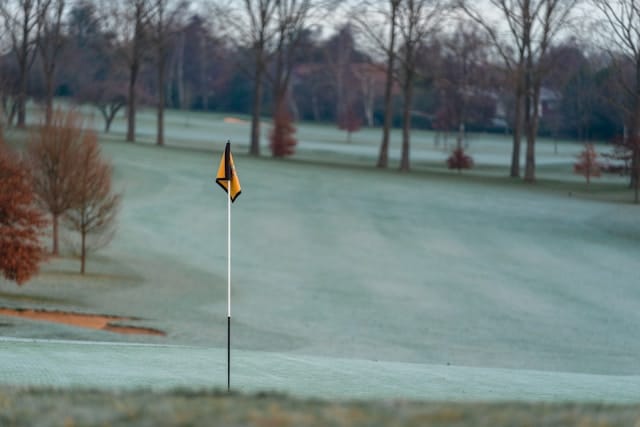
Q
Q-School: Short for Qualifying School, which is a series of tournaments that aspiring professional golfers must compete in order to earn their PGA Tour card.
Quadruple Bogey: A score of four over par on a single hole.
Quintuple Bogey: A score of five over par on a single hole.
R
Rangefinder: A device used to measure distances on the course, often used by golfers to determine how far they need to hit their shots.
Ready Golf: Playing ready golf means playing when you are ready rather than strictly following the traditional order of play. This can help speed up the pace of play on the course.
Reading The Green: The process of examining the slope, grain and condition of the green to determine how a putt will break.
Rough: The area of the course that is covered with long grass, often making it difficult to play a shot with precision.
Road Hole: The notoriously difficult 17th hole at St. Andrews Old Course, which is known for its steep bunker and narrow fairway.
Round: A completed 18-hole game of golf, or four rounds in professional tournaments.
R&A: The Royal and Ancient Golf Club of St Andrews, a historic Scottish golf institution that, together with the United States Golf Association (USGA), governs the sport of golf worldwide, except in the United States and Mexico.
S
Sandbagger: A golfer who misrepresents their playing abilities to gain an advantage in competition, often by artificially inflating their handicap.
Sand Save: When a player successfully gets the ball out of a bunker and into the hole with two shots or less.
Sandy: Slang term for making par after being in a bunker on the previous shot.
Sand Trap: Another term for a ‘bunker’, an area filled with sand designed to hinder the golfer’s play.
Sand Wedge: A type of club with a high loft (around 56 degrees) that is primarily used for hitting shots out of bunkers or from soft lies around the green.
Scramble: A format of play where players compete in teams, and each team member hits a shot then decides which ball to play from next.
Scratch: A player whose handicap is zero, meaning they are expected to shoot par on a course.
Shank: A shot where the ball is struck with the hosel of the club, causing it to shoot off at an unintended angle. This is often referred to as one of the worst shots in golf.
Shotgun Start: A tournament format where
Skins Game: A game played between two or more players where each hole is worth a certain amount of money, and the player with the lowest score on that hole wins the money.
Slope: A number assigned to a course representing its difficulty for a bogey golfer, with higher numbers indicating a more challenging course.
Slice: A common mistake for right-handed golfers where the ball curves sharply from left-to-right in its flight path, usually resulting from an open clubface at impact.
Snowman: A score of eight on a single hole.
Stableford: A scoring system where points are awarded based on the number of strokes taken on each hole, with higher scores being better.
Stance: The position and posture of a player’s feet in relation to the ball before taking
Stroke Play: A format of play where each player counts the total number of shots taken over the entire round or tournament, and the player with the lowest score wins.
Swing Arc: The path that the clubhead takes during a golf swing, from the backswing to the follow-through.
Swing Plane: The imaginary plane that extends from the ball through the golfer’s shoulders, representing the ideal path for a club to swing on during a shot.
T
Takeaway: The first part of the golf swing, where the club is moved away from the ball to initiate the backswing.
Tap In: A short putt that is easy to make, often considered a ‘gimme’ in casual play.
Tee: A small peg on which golf balls are placed for the first stroke of each hole. It can be made of wood or plastic and comes in different lengths depending on a player’s preference or the club they use.
Tee Box: The area designated for players to tee off from on each hole. Often marked by different colored markers to indicate the level of difficulty and distance.
Tee Time: The specific time a player is scheduled to begin their round of golf.
Tending The Flag: Holding the flagstick and removing it from the hole while players putt, then replacing it once all players have holed out.
Texas Wedge: When a player uses their putter to chip or pitch the ball instead of using a pitching wedge or sand wedge.
The Turn: The midpoint of the round, typically after nine holes have been completed.
Topped Shot: A shot where the clubhead strikes the top of the ball, resulting in a low, rolling shot. This is often considered one of the worst shots in golf.
Thin: A shot where the club makes contact with the top half of the ball, causing it to travel lower and farther than intended.
Tiger Slam: The achievement of winning all four major championships in a row, accomplished by Tiger Woods in 2000-2001.
Topspin: A type of spin on the ball that causes it to rotate forward, which can lead to a straighter and slightly longer shot.
U
Up and Down: A golfer successfully getting the ball into the hole in two strokes after a ‘shot out of a hazard’ or from the rough.
Unplayable Lie: When a ball comes to rest in a position where it is nearly impossible for the golfer to make a stroke without causing some form of injury or excessive play.
Uphill Putt: A putt that is rolling upward with the slope of the green, requiring additional speed to reach the hole.
USGA: The United States Golf Association, the governing body of golf in the United States and Mexico.
V
Vardon Grip: A golf grip style where the pinky finger of the trailing hand (the right hand for right-handed golfers) overlaps the pointer finger of the lead (left) hand, named after Harry Vardon. This is also known as the overlap grip.
W
Waggle: A small back-and-forth movement of the club before starting the swing, used to loosen muscles and indicate readiness.
Water Hazard: Any body of water on a golf course, which often requires players to play their shot while standing in or next to it.
Weak Grip: A golf grip style where the lead (left) hand is rotated more to the right, resulting in less control but more power.
Whiff: When a player attempts to hit the ball but completely misses, resulting in a swing with no contact.
Winter Rules: Also known as ‘preferred lies’, this is a temporary rule that allows players to improve their lie by moving the ball within one club length, typically used during winter months when courses are wet or muddy.
Wedge: A type of iron club with a very high loft, used for short approach shots, chips, and pitches, as well as for shaping shots.
X
X-Out: A term used for golf balls that have a minor manufacturing defect and cannot be sold as first-quality.
X-Stiff: A designation on a golf club or shaft that indicates a higher degree of stiffness.
Y
Yips: A slang term for a situation where a golfer loses their ability to control their shot, often manifested in putting, due to nerves or pressure.
Yardage: The distance between the ball and the hole, or any measured distance on the golf course.
Z
Zinger: An exceptionally well-struck shot that carries a long way, often with a nice trajectory and a satisfyingly loud sound off the clubface.
Zip: The amount of spin a golf ball has, often used in discussions about wedge play and approach shots.
Zone: A mental state in which a golfer is intensely focused and performing at their peak, often associated with a string of excellent shots or a particularly good round.
The Bottom Line
I put this guide together to serve as a starting point for golfers wishing to brush up on their jargon. If you’re looking to speak the language of the fairways, this A to Z of golfing terms covers you from the initial drive to the final putt.
Sean’s parents first put a golf club in his hands at the age of 8. He immediately fell in love with the game of golf. Today he’s passing on that love to his own kids.

